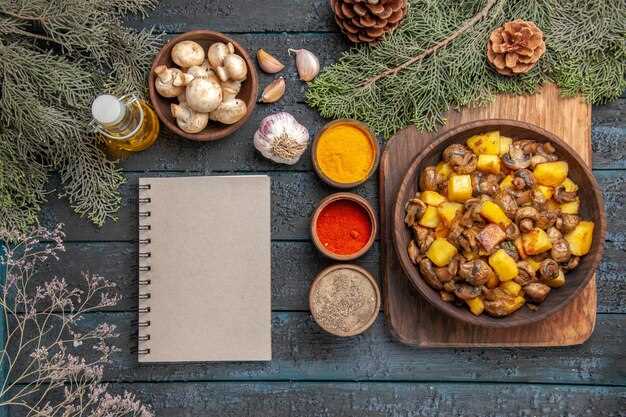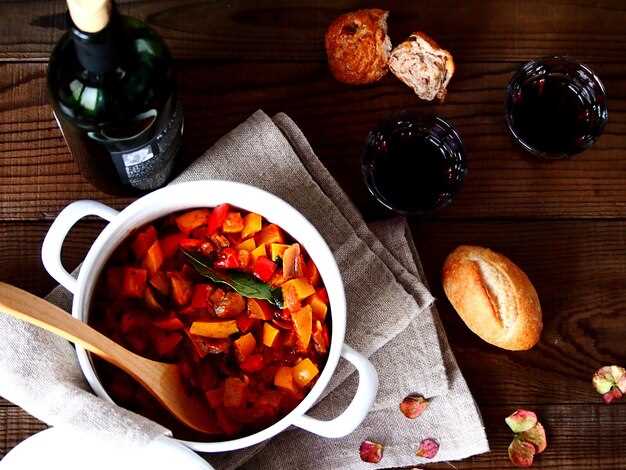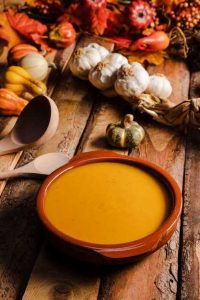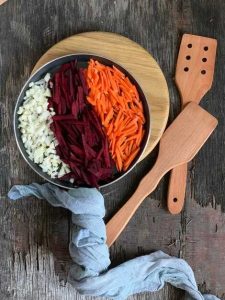Treat yourself to a warming dish that wraps you in comfort and flavor. Our Root Veg Stew with a Mulled Whiskey Glaze offers the perfect blend of seasonal ingredients, crafting an experience that’s as cozy as it is delicious. By integrating winter vegetables like parsnips, carrots, and sweet potatoes, this stew brings natural sweetness and earthy tones to your table. Each ingredient is carefully chosen to complement the others, creating a harmony of tastes that’s both rustic and refined.
The secret to elevating this dish lies in the Mulled Whiskey Glaze. With its rich blend of spices like cinnamon, cloves, and star anise, the glaze is simmered to perfection with a good-quality whiskey. The alcohol enhances the flavors, while the spices infuse a warmth that resonates throughout the stew. Glazing the stew not only adds depth but also a subtle, luxurious touch that’s hard to resist.
As the stew slowly cooks, its aroma fills your kitchen, inviting everyone to gather around. This recipe does more than just feed; it creates moments of togetherness and joy. Served with crusty bread or over a bed of fluffy quinoa, this dish is not only satisfying but also nourishing. It’s the kind of meal that encourages slow savors, meaningful conversations, and a true sense of hygge.
Creating the Perfect Root Veg Stew

Begin with selecting the freshest root vegetables. Carrots, parsnips, and sweet potatoes are excellent choices. Dice them into even, bite-sized pieces to ensure uniform cooking. This step is crucial for achieving a harmonious blend of flavors and a delightful texture.
Sauté onions and garlic in olive oil until they become translucent. This foundation enhances the flavors of the root vegetables. Add a sprinkle of thyme and rosemary to the onions and garlic for a fragrant aroma that sets the stage for the stew.
Incorporate a splash of vegetable broth and allow the mixture to simmer. A slow cook enriches the stew with depth and complexity. Maintain a gentle simmer to avoid breaking down the vegetables too much, preserving their shape and texture.
Introduce a hint of maple syrup to balance the earthy tones with a touch of sweetness. This addition elevates the stew, making it warm and inviting. Remember to adjust the seasoning with salt and black pepper, tasting as you go to find the perfect balance.
To finish, add a handful of fresh parsley for a burst of color and freshness before serving. This final flourish not only brightens the dish visually but also adds a layer of freshness that complements the rich flavors of the stew. Enjoy this hearty dish on its own or pair it with a warm bread roll for an added comfort touch.
Choosing the Best Winter Root Vegetables

Select sturdy root vegetables for your winter stew to ensure depth of flavor and robust texture. Prioritize freshness by checking firmness and smoothness. Avoid those with soft spots or blemishes as they indicate age or poor storage. Here are top choices to enhance your dish:
- Carrots: Opt for deep orange carrots, rich in beta-carotene, vitamin A, and sweetness. Thin, even-sized pieces cook evenly and melt into the stew.
- Parsnips: Choose creamy white, firm parsnips. Their nutty flavor complements sweeter roots and adds a pleasant earthy note to your meal.
- Turnips: Ideal for balancing flavors, their peppery zest comes alive when simmered. Smaller turnips tend to be sweeter, while larger ones can be slightly woody.
- Swedes (Rutabagas): Seek out smaller-sized swedes with purple and beige skin. They boast a delicate sweetness and a hint of bitterness, enhancing complexity.
- Beets: Select medium-sized beets for a touch of earthiness and vibrant color. Their natural sugars caramelize during cooking, adding depth.
These choices will contribute dynamic flavors and textures, making your Winter Hygge Menu comforting and satisfying. Experiment by combining different roots for a harmonious blend that dazzles your palate.
Step-by-Step Cooking Instructions
Chop your carrots, parsnips, and potatoes into bite-sized cubes for even cooking. Mince garlic and finely chop onions for a flavorful base.
Heat a tablespoon of olive oil in a large pot over medium heat. Add onions and garlic, sautéing until the onions turn translucent, about 3-4 minutes.
Add the chopped root vegetables to the pot, stirring occasionally. Allow them to cook for about 10 minutes until slightly softened.
Pour in vegetable broth and bring the mixture to a simmer. Add bay leaves, thyme, salt, and pepper to taste. Let it simmer for 20-25 minutes or until the vegetables are tender.
While the stew simmers, prepare the mulled whiskey glaze. In a small saucepan, combine whiskey, sugar, cloves, cinnamon sticks, and orange zest. Heat the mixture over low heat, stirring until the sugar dissolves completely.
Remove the saucepan from heat and strain the glaze to remove the spices. Set it aside to cool slightly.
Once the root vegetables are tender, remove the bay leaves. Serve the stew in bowls, drizzling the fragrant mulled whiskey glaze over the top. Garnish with fresh parsley for an aromatic finish.
Pair with warm, crusty bread to soak up the savory broth, completing this cozy winter meal.
Flavor Enhancements and Pairings
Enrich the root veg stew with a hint of smoked paprika. This spice adds an earthy depth, harmonizing perfectly with the stew’s natural sweetness. To complement the mulled whiskey glaze, include a touch of cinnamon and clove, enhancing the glaze with warm, aromatic notes without overpowering the dish.
Consider pairing this hearty stew with a side of crusty sourdough bread. Its tangy flavor cuts through the richness of the stew, while its texture is perfect for soaking up every bit of the delicious glaze. A green salad with a tart vinaigrette also balances the flavors, adding freshness and brightness.
For beverages, opt for a glass of malty Scotch ale. Its caramel undertones mirror the whiskey glaze, creating a seamless pairing. Alternatively, a cup of spiced chai provides a non-alcoholic option, echoing the stew’s cozy spices and complementing its complex flavors.
Storage and Reheating Tips
Cool the Root Veg Stew completely before storing to retain its flavor and texture. Transfer the stew to airtight containers, leaving an inch of space to accommodate any expansion as it freezes. For refrigeration, use the stew within 3-4 days to enjoy optimal taste. If freezing, ensure the stew lasts up to 3 months by labeling with the date.
| Storage Method | Duration | Instructions |
|---|---|---|
| Refrigerator | 3-4 days | Keep in airtight containers, consume promptly to maintain quality. |
| Freezer | Up to 3 months | Use freezer-safe containers, label with date for reference. |
To reheat, thaw frozen stew overnight in the refrigerator for a smoother texture. For quick reheating, use a microwave-safe bowl, covering to prevent drying. Heat in 1-minute intervals, stirring in between, to evenly distribute warmth. Alternatively, reheat on the stovetop over medium heat, stirring occasionally until piping hot.
Avoid reheating more than once to preserve nutritional value and flavor integrity. Consider portioning the stew before storage for convenient reheating and reduced waste.
Indulging in Seasonal Winter Delights

Curl up by the fire with a hearty bowl of root vegetable stew, simmered to perfection with a mélange of parsnips, carrots, and sweet potatoes. To elevate this comforting dish, try glazing it with a fragrant mulled whiskey sauce. Start by gently heating whiskey with cinnamon sticks, cloves, and a touch of honey, allowing the spices to infuse the warm spirit. The result is a glaze that not only adds depth to your stew but also fills your kitchen with the inviting scents of winter spices.
Pair your stew with freshly baked crusty bread. For an added twist, consider a loaf infused with rosemary. The herb’s earthy aroma blends seamlessly with the stew’s richness, creating a harmonious balance of flavors. Finish your meal with a warm mulled cider, enhanced with orange slices and star anise, to carry the theme of coziness throughout.
Invest time in selecting seasonal, locally sourced ingredients to enjoy the freshest flavors. Winter farmers’ markets often offer an array of robust root veggies, ensuring each bite of your stew packs a punch of nutrition and taste. With these ingredients, your winter menu will not only satisfy but also create cherished moments of warmth and indulgence.
Exploring Winter Seasonal Ingredients
Enhance your root vegetable stew by incorporating key winter produce like parsnips, carrots, and sweet potatoes. Each contributes a unique sweetness and depth to your dish. Parsnips offer a nutty flavor, especially when roasted. Pair them with carrots that bring a natural earthiness. Sweet potatoes add a creamy texture, complementing the robustness of the stew.
Fresh herbs play a pivotal role in elevating your winter dishes. Thyme and rosemary thrive in cold months, infusing aromatic warmth and a hint of pine. Add them towards the end of cooking to retain their bright, fresh qualities.
For an extra layer of flavor, include alliums like onions and garlic. Slow-cooking these ingredients caramelizes their sugars, bringing out a mild sweetness that enhances the stew’s complexity. Leeks, with their subtle richness, also serve as an excellent complement.
Incorporate winter greens like kale or Swiss chard for added texture and nutrition. A quick sauté keeps them vibrant and slightly crisp. They provide a balanced contrast to the root vegetables, with a slightly bitter edge that cuts through the stew’s richness.
Experiment with spices like cinnamon and cloves for warming notes that harmoniously blend with the mulled whiskey glaze. These spices highlight the natural sweetness of root vegetables and create a comforting aroma synonymous with winter.
Integrating Hygge Elements into Your Menu
Begin by focusing on comfort and warmth; consider incorporating hearty root vegetable stews that offer both nutrition and coziness. Utilize ingredients like carrots, parsnips, and sweet potatoes, which not only lift moods but also have rich flavors that warm the soul. Pair these with a Mulled Whiskey Glaze to introduce a touch of indulgence and enhance the dining experience with familiar holiday aromas.
Encourage a slow-paced dining approach. Serve meals that facilitate leisurely eating, allowing guests to savor each bite. This can be achieved by offering shared platters, allowing diners to pass and share dishes, creating a sense of community and connection.
Incorporate elements of rustic simplicity. Use earthy dishware and wooden serving boards to align with natural aesthetics. Choose lighting that is warm and inviting, mimicking the soft glow of candlelight, to foster a tranquil atmosphere.
Offer a selection of warm drinks with an emotional touch. Consider serving spiced teas and rich hot chocolates, alongside the mulled whiskey, to complement the cozy atmosphere. These drinks should not only warm the body but also evoke the simple pleasure of homely comforts.
Cater to the sense of smell with aromatic spices like cinnamon, nutmeg, and cloves. These spices not only enhance flavors but also fill the space with scents associated with fond memories and comfort, enriching the overall Hygge experience.
Complementary Beverages for Winter Recipes
Hot spiced apple cider perfectly complements the savory and sweet blend of a root vegetable stew with mulled whiskey glaze. The warmth and subtle sweetness of the cider enhance the earthy flavors of the root vegetables, while the spices in both the cider and the glaze create a harmonious taste profile. Homemade cocoa, infused with a hint of cinnamon or nutmeg, offers a rich and indulgent pairing, especially when served with a generous dollop of whipped cream.
- Spiced Apple Cider: Add cinnamon sticks, cloves, and orange slices to your apple cider and simmer gently. The spices echo those in the mulled whiskey glaze, making each sip a delightful counterpart to the stew.
- Herbal Teas: Consider chamomile or rooibos. Their mild, natural sweetness won’t overpower the stew, while their soothing properties make them perfect for cold evenings.
- Mulled Wine: If you’re seeking something a bit stronger, opt for mulled wine. Its boldness works well with the glaze, creating a cozy and aromatic experience.
- Cranberry Juice: Serve chilled or warmed with a bit of orange zest for a non-alcoholic yet festive choice. Its tanginess provides a refreshing contrast to the savory stew.
Whether you prefer the lightness of a tea or the robustness of a mulled wine, these drinks not only satisfy taste buds but also turn any winter gathering into a memorable celebration. Pair them thoughtfully with your menu to enhance each element of your cozy meal.
Q&A:

What ingredients are necessary for making the root vegetable stew described in the article?
The root vegetable stew typically requires a variety of robust and earthy vegetables like carrots, parsnips, potatoes, and turnips. These are the foundational elements of the dish, providing both nutrition and flavor. For the mulled whiskey glaze, you’ll need whiskey, sugar, cinnamon sticks, cloves, and possibly star anise to achieve that warm, spiced flavor characteristic of winter dishes. These ingredients come together to create a hearty and comforting meal celebrated in hygge traditions.
Can you suggest any variations to the root vegetable stew for someone with dietary restrictions?
Absolutely. For those who are vegan, simply omit any non-plant ingredients or use plant-based alternatives. You can substitute the traditional broth with vegetable stock. If you’re gluten-free, make sure any thickening agents or pre-packaged spices used do not contain gluten. Additionally, to reduce sugar, you could experiment with natural sweeteners like honey or maple syrup in moderate amounts for the glaze.
How does the mulled whiskey glaze enhance the flavor profile of the stew?
The mulled whiskey glaze adds a dimension of warmth and depth that complements the earthiness of the root vegetables. The whiskey provides a rich, smoky note, which is balanced by the sweetness of the sugar and the gentle heat from the spices like cinnamon and cloves. This combination results in a complex and layered flavor that elevates the overall taste experience of the stew, making it perfect for cozy winter evenings.
Is this recipe suitable for a large gathering, and how can it be adjusted for a crowd?
This recipe is well-suited for large gatherings, as it can be easily scaled up to accommodate more servings. You’ll need to increase the quantities of each ingredient proportional to the number of guests. Ensure your cooking pot is large enough to handle the volume, and consider preparing the stew in batches if necessary. The slow-cooked nature of the dish makes it a great choice for hosting, as it can be kept warm and served over an extended period.


